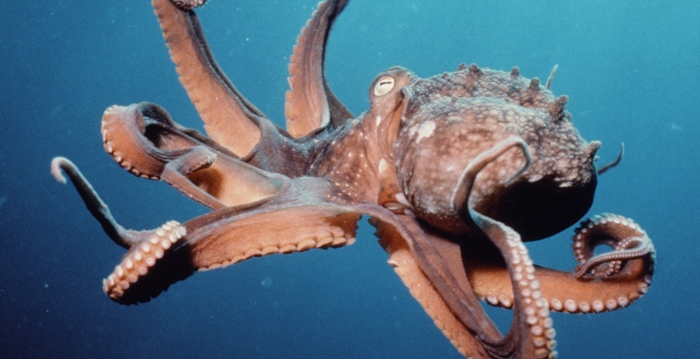
| The Uncanny Cephalopods - Introduction |
The Phylum Mollusca contains over 93,000 recognized species alive today, including over 70,000
Gastropoda - slugs, snails and nudibrancs - and over 20,000 Bivalvia - the clams, oysters and
mussels. We rarely view such creatures as the pinnacle of evolution, with their rudimentary brains
and slimy, (often literally) sluggish bodies, but one of its smaller groups, the Cephalopods, are
counted by many among the most complex, mysterious and sophisticated life-forms known to modern
science. With less than a thousand described species to their name, the Cephalopoda continue to
surprise even the most seasoned biologists with their peculiar adaptations and behavior.
Gastropoda - slugs, snails and nudibrancs - and over 20,000 Bivalvia - the clams, oysters and
mussels. We rarely view such creatures as the pinnacle of evolution, with their rudimentary brains
and slimy, (often literally) sluggish bodies, but one of its smaller groups, the Cephalopods, are
counted by many among the most complex, mysterious and sophisticated life-forms known to modern
science. With less than a thousand described species to their name, the Cephalopoda continue to
surprise even the most seasoned biologists with their peculiar adaptations and behavior.
So what defines a Cephalopod? The name means "head foot," and one look at a typical octopus
should tell you why. Where a snail or mussel has a single, tongue-shaped "foot" of solid muscle, a
Cephalopod bears a ring of incredibly strong tentacles encircling the mouth; anatomically the
same single "foot" in a more complex shape. These "arms" may be lined with dozens or even
hundreds of powerful suckers, each of which can be likened to an entire human hand in its
dexterity and sensitivity.
should tell you why. Where a snail or mussel has a single, tongue-shaped "foot" of solid muscle, a
Cephalopod bears a ring of incredibly strong tentacles encircling the mouth; anatomically the
same single "foot" in a more complex shape. These "arms" may be lined with dozens or even
hundreds of powerful suckers, each of which can be likened to an entire human hand in its
dexterity and sensitivity.
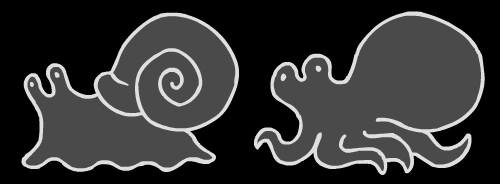
Perhaps the most amazing trait of any cephalopoda are the camouflaging techniques of the
octopuses, cuttlefish and to a lesser extent the squid. In all three of these images, an octopus
hides in plain view. In the blink of an eye, it can change not just the coloring but even the texture of
its surface, bunching up its skin cells into whatever lumps, wrinkles and leafy protrusions will blend
best with its surroundings. Color change is accomplished by the expansion and contraction of
specialized cells called chromatophores, each containing a single color pigment. Imagine a board of
tiny blue, yellow and red lights. Turn off the red lights, and the board would appear green from a
distance. This is more or less exactly what an Octopus or Cuttlefish does with millions of cells
packed into every inch of its skin surface.
Of course, it takes a highly active brain to keep this wild anatomy synchronized, and among all
invertebrates (which comprise the majority of life on this planet) our head-feet are by far the most
intelligent by any measurable definition. Octopuses in captivity can learn to solve complicated
puzzles, mazes and obstacle courses to reach their next meal, recognize the faces of their human
handlers and even demonstrate "play" behavior, a quality unheard of in other cold-blooded
creatures. They have shown a fascination for floating plastic toys, and seem to enjoy re-arranging
or stacking the rocks and shells around their home.
octopuses, cuttlefish and to a lesser extent the squid. In all three of these images, an octopus
hides in plain view. In the blink of an eye, it can change not just the coloring but even the texture of
its surface, bunching up its skin cells into whatever lumps, wrinkles and leafy protrusions will blend
best with its surroundings. Color change is accomplished by the expansion and contraction of
specialized cells called chromatophores, each containing a single color pigment. Imagine a board of
tiny blue, yellow and red lights. Turn off the red lights, and the board would appear green from a
distance. This is more or less exactly what an Octopus or Cuttlefish does with millions of cells
packed into every inch of its skin surface.
Of course, it takes a highly active brain to keep this wild anatomy synchronized, and among all
invertebrates (which comprise the majority of life on this planet) our head-feet are by far the most
intelligent by any measurable definition. Octopuses in captivity can learn to solve complicated
puzzles, mazes and obstacle courses to reach their next meal, recognize the faces of their human
handlers and even demonstrate "play" behavior, a quality unheard of in other cold-blooded
creatures. They have shown a fascination for floating plastic toys, and seem to enjoy re-arranging
or stacking the rocks and shells around their home.
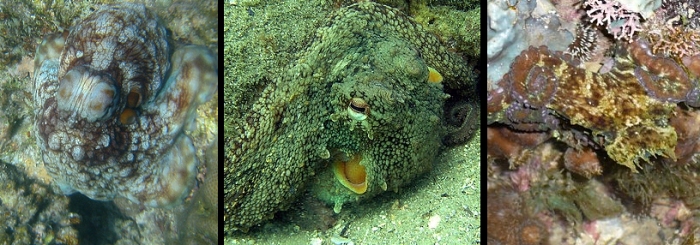
| SQUID OR OCTOPUS? |
Believe it or not, there are some people who still don't know the difference between a squid and
octopus off-hand. If you're among these poor, unfortunate souls, here's a handy guide that I've
drawn just for you...and I won't tell anyone, I promise.
octopus off-hand. If you're among these poor, unfortunate souls, here's a handy guide that I've
drawn just for you...and I won't tell anyone, I promise.
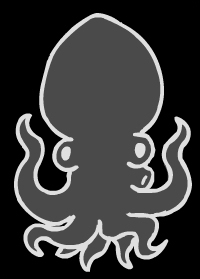
Octopuses (the correct plural term!) belong to their own
superorder, the Octopodiformes. They possess eight identical
arms, bag-shaped heads and an amazing fluidity.
No matter how massive the rest of its body, an octopus can
squeeze itself through any opening that fits its eyeballs and
beak.
Though able to swim when necessary, they usually slither and
crawl along the sea floor, using stealthiness to hunt and evade
predators. They also possess a siphon on one side of the
body, which can expel water for emergency jet propulsion.
superorder, the Octopodiformes. They possess eight identical
arms, bag-shaped heads and an amazing fluidity.
No matter how massive the rest of its body, an octopus can
squeeze itself through any opening that fits its eyeballs and
beak.
Though able to swim when necessary, they usually slither and
crawl along the sea floor, using stealthiness to hunt and evade
predators. They also possess a siphon on one side of the
body, which can expel water for emergency jet propulsion.
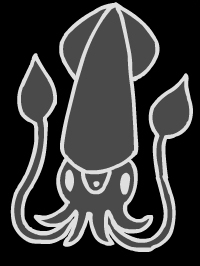
Squid, along with cuttlefish, are of the Decapodiformes. In
addition to their eight short arms are a pair of elongated,
retractable "whips" ending in flattened pads, which "shoot out"
to ensare prey very much like the tongue of a chameleon.
The Squid's body is pointed and finned like a torpedo, more
solid than that of an octopus and built more for high-speed
hunting in the open water.
The siphon is centered and in much more frequent use. Many
species also have an internalized shell, called a cuttlebone in
cuttlefish and a gladius in squid. Octopuses have no remnant
of a shell at all.
addition to their eight short arms are a pair of elongated,
retractable "whips" ending in flattened pads, which "shoot out"
to ensare prey very much like the tongue of a chameleon.
The Squid's body is pointed and finned like a torpedo, more
solid than that of an octopus and built more for high-speed
hunting in the open water.
The siphon is centered and in much more frequent use. Many
species also have an internalized shell, called a cuttlebone in
cuttlefish and a gladius in squid. Octopuses have no remnant
of a shell at all.
By now, you should be familiar with the basic characteristics of these wonderful animals, and are
probably thinking that they couldn't get much stranger. Continue reading, and you may think
differently.
probably thinking that they couldn't get much stranger. Continue reading, and you may think
differently.
All Cephalopods are carnivorous, equipped with both a tooth-covered tongue or "radula" and a
razor-sharp beak that can crack open the toughest crustaceans. This beak is not a distinct body
part itself, but formed by a gradual hardening of the flesh surrounding the mouth. This perfect
gradient from soft to hard tissue is seen almost nowhere else in nature, and prevents the beak
from being easily torn loose without a skeleton to connect with.
razor-sharp beak that can crack open the toughest crustaceans. This beak is not a distinct body
part itself, but formed by a gradual hardening of the flesh surrounding the mouth. This perfect
gradient from soft to hard tissue is seen almost nowhere else in nature, and prevents the beak
from being easily torn loose without a skeleton to connect with.
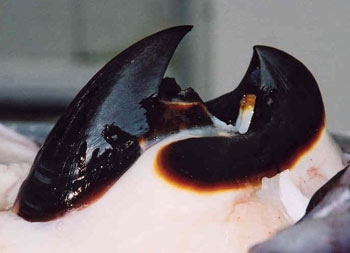

In many species, especially octopods, the tentacles are joined by an umbrella-like webbing
of skin that can be fully unfurled or retracted as the situation warrants. This webbing is a
versatile appendage all its own, employed both in swimming and in capturing live prey.
of skin that can be fully unfurled or retracted as the situation warrants. This webbing is a
versatile appendage all its own, employed both in swimming and in capturing live prey.
| Written by Jonathan C. Wojcik |